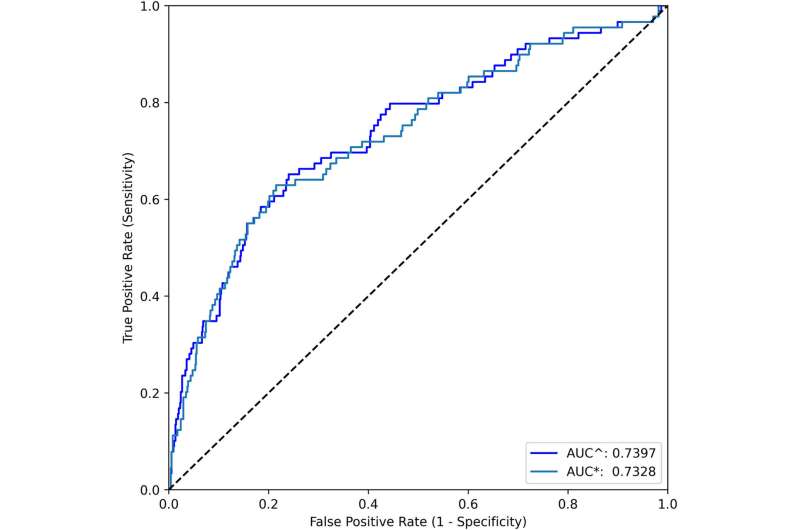This article has been reviewed according to Science X's editorial process and policies. Editors have highlighted the following attributes while ensuring the content's credibility:
fact-checked
peer-reviewed publication
trusted source
proofread
Researchers design machine learning models to better predict adolescent suicide and self-harm risk

Artificial intelligence can help to identify risk factors for suicide and self-harm, according to new research from UNSW Sydney.
Among adolescents in Australia, suicide is the leading cause of death and self-harm affects 18% of those aged 14–17. Both have sadly become more common in this age group over the last decade.
Clinicians assess suicide and self-harm risk when a young person enters a health care setting, like a hospital, with potential suicidal or self-harming behavior. Current risk assessment methods such as looking at past attempts can be unreliable, not taking into account the many other potential risk factors. Also, adolescents outside these health care settings fly under the radar.
Artificial intelligence (AI) is becoming more widely used in mental health to identify at-risk individuals. Machine learning (ML) models can process vast amounts of patient data, identifying potential risk factors and measuring how they can predict mental health issues including suicide and self-harm attempts.
Researchers from UNSW, the Ingham Institute for Applied Medical Research and South Western Sydney Local Health District (SWSLHD) have developed ML models to predict the risk of suicide and self-harm attempts in adolescents. These models were more accurate than a standard approach, with previous suicide and self-harm attempts as the only risk factor.
The findings are published in Psychiatry Research.
"Sometimes we need to digest and process a lot of information that would be beyond the ability of the clinician," says senior author Dr. Daniel Lin, who is a psychiatrist and mental health researcher affiliated with UNSW, the Ingham Institute and SWSLHD.
"That's the reason we are tapping into machine learning algorithms."
High prevalence of suicide and self-harm
The researchers used data from the Longitudinal Study of Australian Children, which has been collecting a range of data from children across the nation since 2004. Their analysis included 2809 of the study participants, split into a 14–15 years age group and a 16–17 years age group. The data came from questionnaires completed by the children, their caregivers and their school teachers.
Among the 2809 participants, 10.5% reported an act of self-harm and 5.2% reported attempting suicide at least once in the past 12 months.
"These behaviors are definitely under-reported, so the actual proportions are higher," Dr. Lin says.
Identifying risk factors
The researchers identified more than 4,000 potential risk factors from the data, relating to areas like mental health, physical health, relationships with others, and the school and home environment. They used a random forest classification algorithm (an advanced ML technique) to identify which risk factors at age 14–15 were most predictive of suicide and self-harm attempts at age 16–17.
For suicide and self-harm, the most important risk factors were depressed feelings, emotional and behavioral difficulties, self-perceptions, and school and family dynamics. There were also unique factors specific to either suicide or self-harm.
"A unique predictor of suicide was lack of self-efficacy, when someone feels a lack of control over their environment and their future. And a unique predictor of self-harm was lack of emotional regulation," Dr. Lin says.
"It was surprising to us to see that previous attempts were not among the top risk factors."
Another unexpected finding was the importance of school and family dynamics in predicting suicide and self-harm attempts. According to Dr. Lin, there is a stereotype that people self-harm or die by suicide because of intrinsic poor mental health.
"We found that the young person's environment plays a bigger role than we thought. This is a good thing from the standpoint of prevention, because we now know that there's more we can do for these individuals," Dr. Lin says.
"Parental support and school support is very important… We need to figure out how as a society we can support parenting and school education, to protect our younger generation."
Implications for clinical practice
The researchers created ML models based on the top identified risk factors to predict suicide and self-harm in the study participants. These models were able to predict attempts more accurately than the standard approach, which only considers the person's history of previous attempts.
According to Dr. Lin, ML models like this could support clinicians to assess suicide and self-harm risk in adolescent patients.
"Based on patient information the ML algorithm could calculate a score for each person, and that could be integrated into the electronic medical records system. The clinician could quickly retrieve that information to confirm or tweak their assessment," Dr. Lin says.
However, more research is needed before these ML models can be integrated into clinical care. The models need to be applied to real-life clinical datasets (which will contain less detailed patient information), to validate whether they are still effective at predicting suicide and self-harm attempts. Also, the researchers are seeking to understand how multiple risk factors interact to influence behavior.
"As researchers, we will try to continue to generate more information and more evidence," Dr. Lin says.
"This is the way to convince stakeholders—clinicians, families, patients and the community—that these data-driven approaches are valuable."
More information: Raymond Su et al, Machine learning-based prediction for self-harm and suicide attempts in adolescents, Psychiatry Research (2023). DOI: 10.1016/j.psychres.2023.115446

















